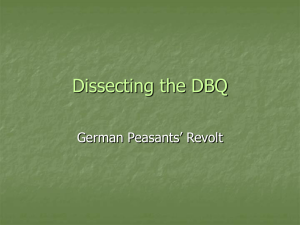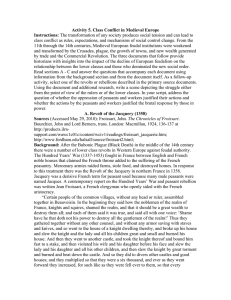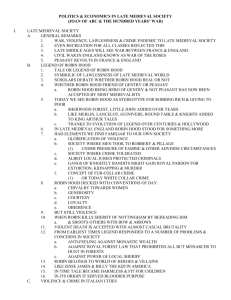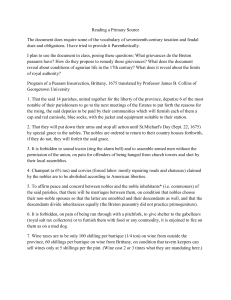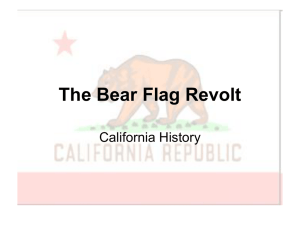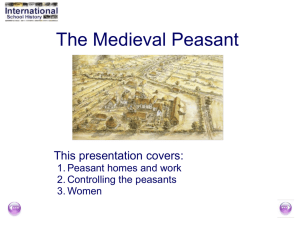The Peasants Revolt
advertisement
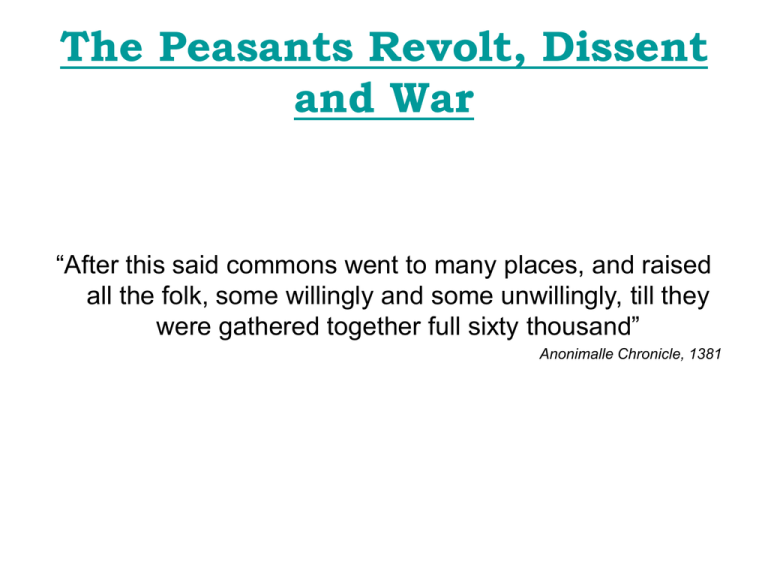
The Peasants Revolt, Dissent and War “After this said commons went to many places, and raised all the folk, some willingly and some unwillingly, till they were gathered together full sixty thousand” Anonimalle Chronicle, 1381 • • • • • • The catalyst for the peasants revolt was very simple – taxation. A poll tax had been levied in 1379 and 1380 to help pay for the ongoing 100 Years War. Peasants initially tried to avoid tax collectors, but in 1381 villagers in Essex started to kill the tax collectors. This soon snowballed into an outright revolt and a call for all peasants to join together. The Lollards helped spread the word The two leaders of the revolt were Wat Tyler and John Ball. • • • • • • • • • Soon it became a revolt against the entire feudal system and the Roman Church. The rebels took Canterbury, burning monasteries, manor houses and destroying all papers/records concerned with serfs and their duties. Anger took them to London on 12th June. The city was taken without a shot being fired. Richard II was as good a prisoner as he was blockaded into the Tower. The rebels were surprisingly disciplined, any looters among them were punished . On 14th June Richard met the rebels and agreed (under pressure from his advisers) to their demands, which were: the abolition of serfdom, a pardon for all involved in the revolt, the right to conduct business, repeal of all labor laws fixing wages to pre-plague levels. Another meeting was arranged for Smithfield to discuss further demands, however, it did not go according to plan and Wat Tyler was fatally wounded. His body was then dragged through London, beheaded, his head stuck on a lance and taken to the rebels. Understandably the peasants were disheartened. They were encouraged to go home as their demands had been met. • • • • • The king, however, had no intention of honouring his pledges. He called on his supporters to put down what was left of the revolt. All demands that had been met were rescinded and anyone suspected of participating in the revolt was summarily executed. Although the peasant revolt had been well and truly defeated, it marked the beginning of the end for feudalism. By 1480 there was hardly a serf left in England. The Lollards • • • • • • • • First English movement resembling Protestantism. John Wycliffe Transubstantiation Itinerant preachers – poor, sick, neglected and diseased Simple life vs. priestly life Lessons of faith rather than ‘mysteries’ Persecuted but never died out Prepared way for 16th century Reformation 1. Hostile to authority, 2.Focus on scriptures, 3. belief in an English bible. 15th Century Developments • • England had become a powerful nation All necessary institutions/activities were in place: – – – – – – Commerce and trade (vs. feudal system) An army (vs. independent knights and armed peasants) Universities (vs. monastic schools) Parliamentary government An established church Culture (indigenous) Parliament • Unique in Europe – – – – • Power to tax Highest court in the land Made and modified existing law MPs also had privilege of free speech and the right not to be arrested while in session. However, still at the King’s disposal. An ‘English’ Church • • • • • • • Shared Catholic faith and doctrine with other Latin churches. Englishness of church more pronounced. English language/English experience/English law/English customs – the faithful (including the clergy) lived within this. The C.of E. was established and patronised by English kings, noblemen and gentry. Bishops were great landowners. The French wars (100 years war) had eroded the power of Rome over the English church. The movement towards an English church can be illustrated with the following developments: – – – Church law limited by royal authority e.g. Pope’s ability to tax clergy was restricted, in reality most papal tax went into royal coffers. Pope’s power to appoint English bishops limited. Anti-papal statutes of 1351 and 1390 plus the Great Schism (1378-1417) meant church appointments were the King’s business. English expressions of faith: The Devotional movement and the Lollards. Chaos and Anarchy • • Sign of the times: Hundred Years war ended in 1453 only for the Wars of the Roses to begin just two years later. Reasons for instability=many but a couple can be isolated: – – Knightly behavior during war and peacetime ‘Legal tricks’ and violence. Period of contrast: • Seen as an age of chivalry, of damsels in distress and knights in shining armor carrying them off. • Reality… – – – – • was that wife beating a recognised right, if a daughter refused to marry her father1s choice, she was likely to be locked up and beaten marriage was for financial advancement. Arranged marriages in the cradle. Yet… – – – Oxford and Cambridge founded E(a)ton and Winchester Reading and writing were no longer the preserve of the Clergy. The Wars Of The Roses • • • • • • No principles involved – wealth, power and ultimately the monarchy. Lancastrians (red) vs. Yorkists (white) Both houses descended from Edward III Noble on noble – life as normal for majority Henry Tudor, Earl of Richmond, came out on top becoming Henry VII after the Battle of Bosworth Field. Won due to luck and good fortune: – – – • • • Richard III and all his advisors/court etc. killed on the field All other contenders already eradicated Henry had proclaimed himself king BEFORE the battle. Henry quickly married Elizabeth of York thus appeasing Yorkists. In 1454 there had been 53 peers in the House of Lords by the war’s end only 18 remained. J.M.Trevalyn “..the Wars Of The Roses were a bleeding operation performed by the nobility upon their own body. To the nation it was a blessing in disguise.”



